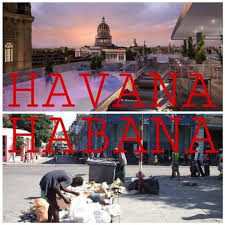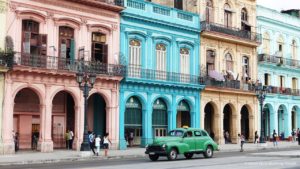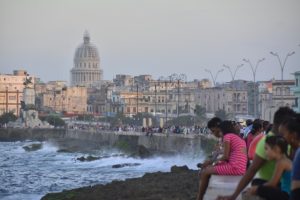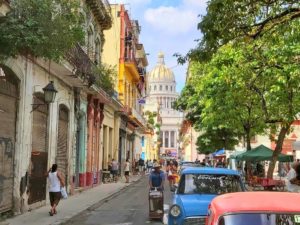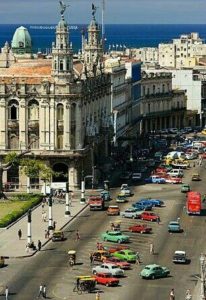HAVANA IS STILL HAVANA, BUT IT WILL NEVER BE THE SAME AGAIN. PHOTOS
Paraphrasing Hemingway in his book “Paris was a party”, these phrases could be applied to Havana: but the saddest and darkest of all: -Paris would never be the same again, although it was still Paris.
Instead, Havana is still Havana, but it will never be the same again.
HAVANA MEMORIES
In Havana, Alejo Carpentier wrote, French commerce was a mainly high fashion for women ”. There were successively several stores on Prado Street that were opened such as the Casa de la Boustiffier, which was almost on the corner of Colón. Later the house of Sara and Queen Marie. There was a luxury food store, which was the Potín house and the French restaurant El París, both on O’Reilly street. But we must not forget the trade for North American tourists, tourism so large that it made the dollar circulate at the same rate as the own currency. Of this, I remember souvenirs for their high quality and in particular the trade in leather goods, including crocodile skin, the most expensive, but whose prices would seem ridiculous today, taking into account their high quality. I remember buying two crocodile skin belts (real as it was at the time) and having spent more than 10 years wearing them and there was no end to it.
The chroniclers called Havana, the Paris of America, amazed travelers, they commented that the Havana society of that time could be compared with the brilliant Parisian society. But above all, “Havana is reputed to be a very happy city, and it is because of this very general idea that it has been called the Paris of America,” said Nicolás Tanco Armero in 1853, a young Colombian adventurer who toured the five continents and became the first citizen of the young country to set foot in China.
THEN HAVANA AND ITS NIGHTLIFE
In Havana, there were about 400 cinemas, a figure that Paris or New York did not have.
The América, Radiocentro, Fausto, Payret, Rodi, Atlantic, or the Blanquita Theater (current Karl Marx Theater) were the best known, the latter with more than 6,600 seats.
In the gardens of the La Polar and La Tropical breweries, in the Puentes Grandes neighborhood, dance sessions lasting several hours were common. Private musical sessions were held at the Gallego, Asturiano, Deportivo La Estrella or Club Candado centers.
The record industry was very powerful. Discuss, Gema, Kubaney, Meca, Montilla, Neptuno, Panart, Puchito, RCA-Víctor, Sonotone and Velvet mainly record Cuban artists. Some also did it on record labels in New York, such as Sonora Mantancera, Celia Cruz or Vicentico Valdés.
The victrolas were essential for the diffusion of new rhythms and artists, becoming a basic resource for the development of the national record industry. In 1956 there were more than 10 thousand victrolas throughout the island installed in bars, bodegones, neighborhoods, shops, and premises set up in the large sugar and rural centers. In the vitrolas located next to nightclubs and bars, the bolero is the music most listened to. I think there was a victrola on every corner. By the way, I always heard everyone at home say: victrola. Then I heard: vitrola. Specialists affirm that it is an error because the word came from R.C.A. Victor. In 2004’s Little Illustrated Larousse, it appears: Vitrola: En América, gramophone. It is an example of how the language varies according to use, even misuse. In the end the name was corrected: “First it was used to reproduce Víctor’s records, then those of other firms, but it continued to be called victrola.” In other countries, it is called interchangeably jukebox, vellonera, jukebox, etc.
Publications such as Bohemia, Carteles, Confidencial, and Show, reflected all the artistic and musical news developed in pre-revolutionary times; information that also has a place in the 58 daily newspapers or the 126 weekly general information magazines published. The numerous English-language press should also be remembered.
In short, Havana was a multifaceted range of entertainment and fun places, and we have not talked about bars, clubs, cabarets, and licentious life.
Experts in Havana’s cultural life, in 1958 affirm that there were almost 1,200 bars or musical nightclubs; 250 social clubs with musical activity; 50 orchestras that habitually played; 100 record stores and 150 shops where you could buy musical instruments. Apart from the great cabarets, such as the Tropicana, Montmartre, Sans Souci, Salón Rojo del Capri and Parisién at the Hotel Nacional, many clubs were famous such as the Sherezade, Pico Blanco at the Hotel San John’s, Atelier, Imágenes and El Gato Tuerto. to be the most visited clubs.
There were also others of great acceptance, such as the Palermo Club, Alloy, Pennsylvania, Sierra, La Campana, Night and Day, Las Vegas, Panchín, Rumba Palace, Bolero Bar, Topeka, La Rue 19, Habana-Madrid Night Club, Habana 1900, La Red or Alí Bar.
Ali Bar, well away from Havana, had one characteristic; Benny Moré, one of the greatest artists of Cuban and universal music, performed in it, accompanied by artists of the stature of Fernando Álvarez, Celeste Mendoza, Orlando Vallejo, and others of renown.
Havana is still Havana, but it will never be the same again.
LA HABANA SIGUE SIENDO LA HABANA, PERO NUNCA VOLVERA A SER IGUAL
Parafraseando a Hemingway en su libro “París era una fiesta”, se podría aplicar a La Habana estas frases: lo más triste y oscura de todo: -“París nunca volvería a ser igual, aunque seguía siendo París”.
En Cambio, La Habana sigue siendo La Habana, pero nunca volverá a ser igual.
LOS RECUERDOS HABANEROS
En La Habana, escribió Alejo Carpentier, el comercio francés era principalmente de altas modas para mujeres”. Había en la calle Prado sucesivamente varias tiendas que se abrieron como la Casa de la Boustiffier, que estaba casi esquina a Colón. Más adelante la casa de Sara y reina Marie. Había una tienda de víveres de lujo, que era la casa Potín y el restaurante francés El París, ambos en la calle O´Reilly. Pero no hay que olvidar el comercio para turistas norteamericanos, un turismo tan grande que hizo que el dólar circulara a la par como la moneda propia. De ello recuerdo por su alta calidad los souvenirs, y en particular el comercio de artículos de piel, entre ellas los de piel de cocodrilo, la más cara, pero cuyos precios nos parecerían ridículos hoy en día, teniendo en cuenta su altísima calidad. Recuerdo haber comprado dos cintos de piel de cocodrilo (reales como era en la época) y haber pasado más de 10 años usándolos y aquello no tenia fin.
A La Habana le llamaban los cronistas, el París de América, viajeros asombrados, comentaban que la sociedad habanera de aquel entonces, podía compararse con la brillante sociedad parisina. Pero por sobre todo “La Habana tiene fama de ser una ciudad muy alegre, y es por esta idea, muy general, que se le ha llamado el París de América” dijo Nicolás Tanco Armero en 1853, un joven aventurero colombiano que recorrió los cinco continentes y se convirtió en el primer ciudadano del joven país en pisar China.
LA HABANA DE ENTONCES Y SU VIDA NOCTURNA
En La Habana había cerca de 400 cines, cifra con la que no contaban París o Nueva York.
El América, Radiocentro, Fausto, Payret, Rodi, Atlantic o el Teatro Blanquita (actual teatro Karl Marx) eran los más conocidos, éste último con más de 6 mil 600 butacas.
En los jardines de las cervecerías La Polar y La Tropical, en la barriada de Puentes Grandes, eran habituales sesiones bailables de varias horas de duración. En los Centros Gallego, Asturiano, Deportivo La Estrella o en el Club Candado se realizaban sesiones musicales privadas.
La industria discográfica era muy poderosa. Discuba, Gema, Kubaney, Meca, Montilla, Neptuno, Panart, Puchito, RCA-Víctor, Sonotone y Velvet graban principalmente los artistas cubanos. Algunos lo hacían también en disqueras de Nueva York, como la Sonora Mantancera, Celia Cruz o Vicentico Valdés.
Las victrolas fueron esenciales para la difusión de nuevos ritmos y artistas, convirtiéndose en un recurso básico para el desarrollo de la industria discográfica nacional. En 1956 había más de 10 mil victrolas en toda la isla instaladas en bares, bodegones, barrios, comercios y locales habilitados en los grandes centros azucareros y rurales. En las vitrolas situadas junto a night clubs y bares, el bolero es la música más escuchada. Creo que habia una victrola en cada esquina. Por cierto, siempre oía decir a todos en casa: victrola. Después escuché: vitrola. Especialistas afirman que se trata de un error, porque la palabra procedía de R.C.A. Víctor. En El pequeño Larousse ilustrado del 2004, aparece: Vitrola: En América, gramófono. Es un ejemplo de cómo la lengua varía según el uso, hasta el mal uso. Al final se corrigió el nombre: «Primero se utilizó para reproducir los discos de la Víctor, luego los de otras firmas, pero siguió llamándose victrola». En otros países se le llama indistintamente rocola, vellonera, gramola, etc.
Publicaciones como Bohemia, Carteles, Confidencial y Show, reflejaban toda la actualidad artística y musical desarrollada en tiempos pre-revolucionarios; informaciones que también tienen cabida en los 58 periódicos diarios o las 126 revistas de información general semanalmente editadas. Debe recordarse también la numerosa prensa en idioma inglés.
En fin que La Habana era un multifacético abanico de lugares de entretenimiento y diversión, y no hemos hablado de los bares, clubes, cabarés y la vida licenciosa.
Expertos en la vida cultural habanera, en 1958 afirman que existían casi mil 200 bares o locales nocturnos musicales; 250 clubes sociales con actividad musical; 50 orquestas que habitualmente tocaban; 100 tiendas de discos y 150 comercios donde se podían adquirir instrumentos musicales. Aparte de los grandes cabares, como el Tropicana, Montmartre, Sans Souci, Salón Rojo del Capri y Parisién del Hotel Nacional, muchos clubes eran famosos como el Sherezade, Pico Blanco del Hotel San John`s, Atelier, Imágenes y El Gato Tuerto pasan a ser los clubes más visitados.
También había otros de gran aceptación, como el Palermo Club, Alloy, Pensylvania, Sierra, La Campana, Night and Day, Las Vegas, Panchín, Rumba Palace, Bolero Bar, Topeka, La Rue 19, Habana-Madrid Night Club, Habana 1900, La Red o el Alí Bar.
Alí Bar, bien alejado de la Habana, tenía una característica; en él actuaba Benny Moré, uno de los más grandes artistas de la música cubana y universal, acompañado por artistas de la talla de Fernando Álvarez, Celeste Mendoza, Orlando Vallejo, y otros de renombre.
La Habana sigue siendo la Habana, pero nunca volvera a ser igual.
Agencies/ MemoriasCubanas/ Carlos RodriguezB./ Extractos/ Excerpts/ Arnoldo Varona/ www.TheCubanHistory.com
THE CUBAN HISTORY, HOLLYWOOD.



 LA HAVANA is Still Havana, but it will Never be the Same Again. PHOTOS. * LA HABANA Sigue siendo la Habana, pero Nunca volvera a ser Igual. PHOTOS.
LA HAVANA is Still Havana, but it will Never be the Same Again. PHOTOS. * LA HABANA Sigue siendo la Habana, pero Nunca volvera a ser Igual. PHOTOS.